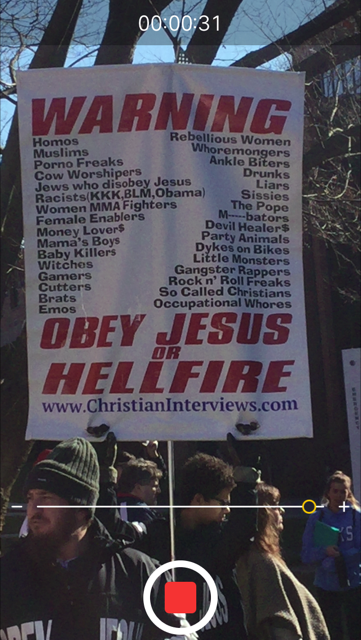A group of Bucks professors and administrators unveiled an unofficial policy on how to respond to a small cohort of religious protestors who have repeatedly appeared on Bucks’s Newtown campus and have been accused of disrupting the educational process.
The policy, which various professors read to their students during the past week, is based on non-engagement and counter-protests. Above all, students are encouraged not to react violently to the activists’ message.
Although many people have had a hand in its development, the policy is largely the work of Charlie Groth, who volunteered along with several other faculty members to write a statement regarding the protest group’s initial demonstration, which occurred in December.
Groth has taught cultural anthropology as well as other courses at Bucks for nearly a decade, and has participated in various community education programs, including the Bucks County Poet Laureate competition. She is an enthusiastic proponent of Bucks and its role in bringing the county together.
“One of the things I love about Bucks is that it is a community college. One of the by-products about teaching close to where I live is that I see my students around town and in the grocery store.”
She was returning from her uncle’s funeral when the protestors, led by a man who calls himself “The Radical Reverend” made their first visit to the Newtown campus.
“He came in and then I overheard him tell one of our students that she looked like a harlot. That’s no way to talk to our students.”
She had recently attended a training on responding to bullying in the classroom. “I think it was helpful. A lot of what he is doing feels like bullying.”
Groth makes known her opposition to the message of the protestors. “It’s shocking, it’s appalling and it’s a little horrifying.” However, she emphasized the importance of reacting calmly and peacefully to their campus visits.
“We were all concerned that our students know that [The Radical Reverend] has this method that gets students to attack him, so that he will be the victim. You shouldn’t take this lightly — you can get arrested, and then you have that arrest on your record.”
Groth explained how the protest leader and his followers use particular strategies and tactics, including the targeting of individuals based on their gender, sexual orientation and lifestyle choices, in order to enrage students and get them to respond physically.
“He is basically harassing people and intermixing it with free speech. He tries to get people to lash out at him so then they are the perpetrator.”
After the first protest, Groth joined together with other professors to produce a statement regarding the protest group.
“Right at the end of the semester, our president put out a call to see if faculty and staff wanted to craft a statement that we could share with our students to tell them how to protect them from arrest.”
The statement, which is promoted by the administration but does not set out mandatory rules, focuses on the creation of an “Angel’s Shield” around the protestor to prevent him from spreading his doctrines. Students and professors are encouraged to stand with backs towards the protestor and chant slogans of acceptance and love.
“There are two basic ways to respond. One is to ignore him. The other is to give a counter message or disrupt him. They are both completely valid,” Groth explained.
“There are reasons why you may choose not just to ignore him. In the LGBT community, they have the idea that silence equals death. So there were various approaches to this, and they’re all valid.”
While she expressed the opinion that no strategy could be universal or perfect, Groth made sure to stress that students should refrain from engaging with, or even laughing at, the protestors.
“I really hope our students can keep themselves safe and not get hurt. It’s complex, as some students come out because it is entertaining. There is a challenge with that, because there will be people who will want to argue with [the protestors] rationally, but the methods they are using aren’t rational.”
Shelli Bookler, a professor of theatre at Bucks who also helped formulate the college’s policy, expressed similar thoughts.
“Students need to feel safe and focus on what they are on campus for — learning. We are a public institution, so we have to deal with it. We need to decrease the spectacle that he is creating so he will get tired and maybe he’ll go away.”
Both professors also believe that the protests could end up bringing students together. “One student said on Thursday that this was the moment that made her proud to be part of Bucks,” Groth smiled.
For now, however, the protestors present an ever-present challenge to students and faculty. “Obviously we want all of our rights to be protected but certainly there is a fine line.”
“It takes some persistence. Free speech and harassment are being linked. And both free speech and preventing harassment are important things in an educational environment. There is no simple answer. I will say that Bucks is doing the best we can.”
Bucks Faculty Respond to Campus Protests
Hal Conte
•
February 16, 2017


